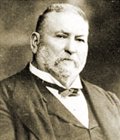Melbourne Tram Museum
- Follow Melbourne Tram Museum on Twitter
- Follow Melbourne Tram Museum on Facebook
- Follow Melbourne Tram Museum on Instagram
- Follow Melbourne Tram Museum on Pinterest
- Follow Melbourne Tram Museum on Tumblr
- Subscribe to Melbourne Tram Museum's RSS feed
- Email Melbourne Tram Museum
Bent by name, Bent by nature
Sir Thomas Bent was a colourful and corrupt Victorian politician incumbent in the late 19th and early 20th century, being prominent in the ranks of the land boomers. It was colloquially said of him at the time that he was ‘Bent by name, Bent by nature’, which is also the title of his definitive biography [1].
 Sir
Thomas Bent.
Sir
Thomas Bent. - Photograph courtesy Parliament of Victoria.
Sir Thomas was the progenitor of the Victorian Railways (VR) owned St Kilda to Brighton Beach electric tramway which opened in 1906. Just by happenstance, this new tram route significantly improved the value of Sir Thomas’ substantial real estate holdings in the area, as well as those of his supporters – since he was the MLA for Brighton, as well as being the Premier, Treasurer and Minister for Railways.
The machinations he undertook to achieve his objective underline his political deviousness and level of ethics. For some time prior to 1903 he had been lobbying to achieve an electric tramway to Elwood and Brighton, but had been unsuccessful due to opposition from the Parliamentary Standing Committee on Railways, which had to approve all railway construction projects in excess of £25,000. This opposition was strongly influenced by the VR Commissioners, who wanted no part in electric tramways, together with the Melbourne Tramway & Omnibus Company, who were not eager to see any competition for their cable tramways.
When he became Premier in 1904, Bent seized his chance to bypass the Standing Committee. He listed for construction an electric street railway from St Kilda to Brighton for a total cost of £19,500. He then appropriated for railway purposes a Treasury fund known as the Country Tramways Trust Fund for a total of £90,782. This artifice was authorised on 30 November 1904 by the Railways Special Applications Act (No 1948), to be followed on the same day by the St Kilda and Brighton Electric Street Railway Act (No 1956), successfully achieving his objective.
This act authorised the construction of a standard gauge tramline from the Acland Street cable tram terminus to Park Street, Middle Brighton.
During construction of the line, a further act (No 1973) was passed to authorise extensions to the original planned line from Acland Street to St Kilda railway station and Middle Brighton to Brighton Beach railway station, as well as changing the gauge to 5'3". During the debate on this act, when challenged as to the source of traffic for this extension, Sir Thomas replied contemptuously to his critic, “From Geelong!”, which is ‘only’ about 40 miles distant as the crow flies across Port Phillip Bay.
The rails were ordered for the extension 13 days prior to the passing of the act.
It was also noted that the Bent ministry of 1904-09 was much more favourably disposed towards the North Melbourne Electric Tramways & Lighting Company (NMETL) proposal to construct the Essendon tramways than the previous Irvine ministry, which had vehemently rejected this tramway scheme. The involvement of former Premier Sir Alexander Peacock, the conservative MLA for Creswick, as NMETL Managing Director may have had something to do with this change of direction.
The Essendon tramway system commenced construction in May 1905, opening on 11 October 1906. At the laying of the first rail of this tramway, in typical Bent style he remarked that he regretted not having been a party to the venture as he was sure that the trams would pay handsomely.
Sir Thomas died in September 1909 from the effects of tertiary syphilis, and is remembered in Melbourne mainly by the name of the south-eastern suburb of Bentleigh (with attendant railway station) and a notably large bronze statue beside Nepean Highway in Brighton.
For more information about Sir Thomas, try the following links:
- http://localhistory.kingston.vic.gov.au/htm/article/74.htm
- http://www.parliament.vic.gov.au/speaker/former/bent.htm
- http://www.parliament.vic.gov.au/re-member/bioregfull.cfm?mid=220
Bibliography
Richardson, J. (1963) The Essendon Tramways, Traction Publications.
Harrigan, L. J. (1962) Victorian Railways to ’62, Victorian
Railways
Marshall-Wood, L. (1966) The Brighton Electric Line, Traction
Publications
Footnotes
[1] Glass, Margaret (1993) Tommy Bent ‘Bent by name, Bent by nature’, Melbourne University Press.